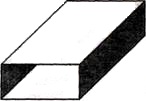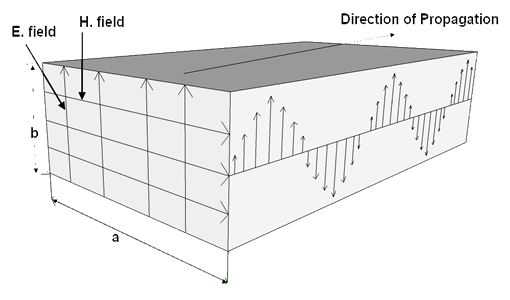Waveguide
Waveguide is the type of transmission line that carries microwave frequencies from source to load. The energy is in the form of an electric field and a magnetic field which are perpendicular to each other the electric field and magnetic field inside. The waveguide is also perpendicular to the direction of propagation as the energy is in the form of an electric/magnetic field. Therefore, it is capable of handling the high power of microwave length of frequencies.
Types of Waveguide:
There are basic two types of waveguides.
- Circular waveguide
- Rectangular waveguide
Construction:
Circular waveguide:
 As shown in the given diagram the circular waveguide is designed from a conducting pipe that is hollow from the center and polished from the interior portion. The outer surface of the waveguide is coded with the insulated paint in order to avoid dust and rust. These types of waveguides are available in different lengths and sizes in order to fulfill the requirements of the circuit.
As shown in the given diagram the circular waveguide is designed from a conducting pipe that is hollow from the center and polished from the interior portion. The outer surface of the waveguide is coded with the insulated paint in order to avoid dust and rust. These types of waveguides are available in different lengths and sizes in order to fulfill the requirements of the circuit.Rectangular Wave Guide:
 As shown in the given diagram, the rectangular waveguide is designed from conducting material in a rectangular shape which is hollow from the center and fully polished from the interior. The outer surface of the waveguide is coded with insulating material or paint in order to avoid dust and rust. These types of waveguides are available in different lengths and sizes in order to fulfill the requirements of the circuit.
As shown in the given diagram, the rectangular waveguide is designed from conducting material in a rectangular shape which is hollow from the center and fully polished from the interior. The outer surface of the waveguide is coded with insulating material or paint in order to avoid dust and rust. These types of waveguides are available in different lengths and sizes in order to fulfill the requirements of the circuit.
Direction of Propagation:

As shown in the given diagram, there are two dimensions of the rectangular waveguide one is the broad dimension and the second is the narrow dimension. The broad dimension is denoted by “a” and the narrow is by “b”. In the waveguide, the electric field and the magnetic field carry the signal from source to load. In this case, the electric field and the magnetic field are perpendicular to each other and at the same time. These fields are perpendicular to the direction of propagation. Inside side the waveguide horizontal field is perpendicular to “a” and the Vertical field is perpendicular to “b” according to the frequency both Horizontal and Vertical fields change their amplitudes and direction as shown in the diagram.
Uses of Wave Guide:
There are the following uses of Wave Guide.
- It is used where the transmission or reception is in the range of microwave frequencies.
- It is also used for handling the high-power of energy.
- It is mostly used in the airborne radar.
- In-ground radar we also use the waveguide.
- The circular waveguide is mostly used in the ground radar to transmit or receive the energy from the antenna. Which revolves in 360o bearing continuously.
- The waveguide is also used in communication systems.
- In satellite communication, the waveguide is mostly used.
- We also use the waveguide in the devices of navigation aids.
- In some cases, the waveguide is used as an attenuator where very high frequencies are involved.
- The waveguides are also used with the cavity resonators to carry the input and output signals.
Flexible Waveguide

It is a type of waveguide that can be easily torn and twisted in circuits to connect the source with the load. This type of waveguide is designed in such a way that the internal portion is made of conducting material in a spring shape. The external portion is covered with rubber to avoid dust, rust, and humidity.
Uses of Flexible waveguide
- The flexible waveguide is used in such microwave equipment where the path from the load to the source is twisty.
- This waveguide is also used to minimize the size and design of the microwave equipment.
- We also used the flexible waveguide to reduce the weight due to the reduction in size and to reduce the space occupied by the microwave types of equipment.
Higher Mode
It is the mode of operation that deals with the high range of frequency. The higher mode is from 30 MHz to 300 MHz in the higher mode the transmission or propagation is carried out through the waveguide in the form of electromagnetic and horizontal fields. TE mode and TM mode are higher modes.
Lower Mode
The mode of operation which deals with the frequency less than 3 MHz is called the lower mode. In this case, the transmission is carried out through the microstrip coaxial cable. The movement of electrons for the flow of current is taken in the lower mode of operation to carry the energy from the source to the load.
